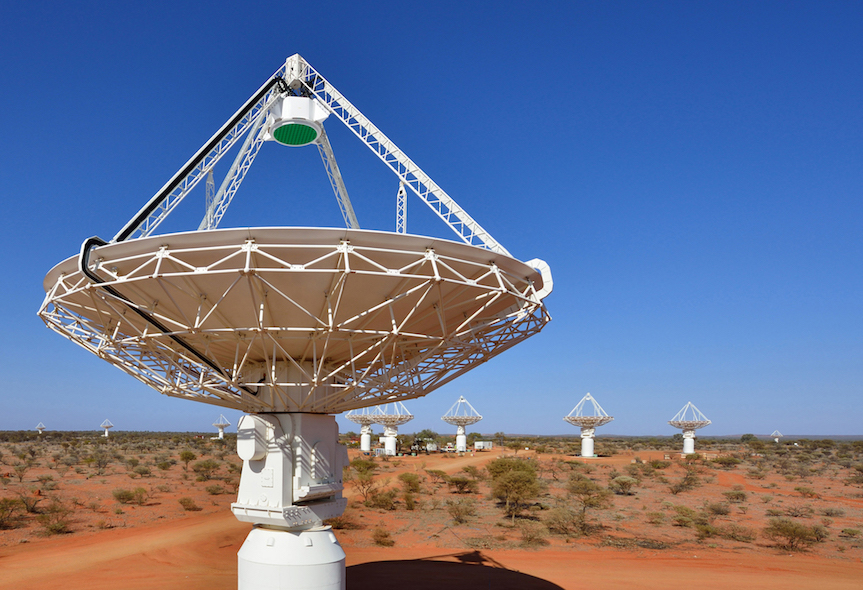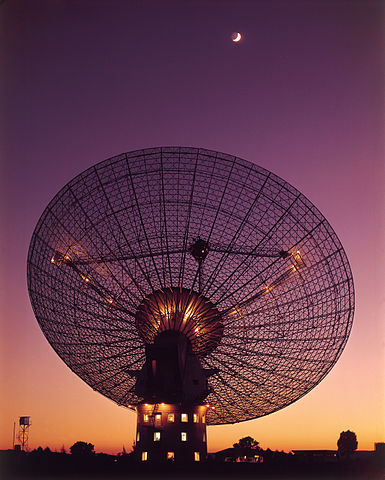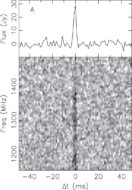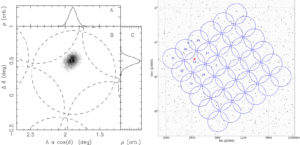
CSIRO
A new telescope, the Australian Square Kilometre Array Pathfinder (ASKAP), has joined the search for energetic and elusive fast radio bursts. And in just a few days of looking, it’s already had success!
Elusive Transients

CSIRO
Fast radio bursts are mysterious millisecond-duration radio pulses that were first discovered around a decade ago. Since that time — particularly in recent years — we’ve made some progress toward the goal of localizing them. We’re now fairly convinced that fast radio bursts come from outside of the galaxy, and yet they’re enormously bright — orders of magnitude more luminous than any pulse seen from the Milky Way.
Better identification of where these mysterious bursts come from would help us to determine what they are. But so far, we’ve discovered only around 30 such bursts, despite the fact that they’re estimated to occur at a rate of ~3,000 events per day across the whole sky.
Why are they so hard to find? Due to their short duration, effective detection would require instantaneous coverage of a very large fraction of the sky. The Parkes radio telescope — which has detected all but five of the fast radio bursts published to date — has a field of view spanning less than a square degree, significantly limiting our ability to rapidly survey for these transients.
A New Array in Town

Bannister et al. 2017
A new player is now on the scene, however, and it’s already had huge success. ASKAP is a wide-field radio telescope made up of an array of 12-meter antennas. Using phased-array-feed technology, ASKAP is able to instantaneously observe an effective area of 160 square degrees — an enormous field compared to Parkes’ 0.6 square degrees! This capability significantly increases our chances of being able to detect fast radio bursts.
In a new study led by Keith Bannister (Australia Telescope National Facility, CSIRO Astronomy and Space Science), a team of scientists presents results from ASKAP’s first 3.4-day pilot survey. Bannister and collaborators announce that in this brief time, ASKAP has already detected a fast radio burst: FRB 170107, an especially luminous, ~2 millisecond burst that confirms the presence of an ultra-bright population of fast radio bursts.
Looking to the Future

Adapted from Bannister et al. 2017
The discovery and characterization of a burst already after such a short initial campaign suggests that ASKAP will become a very powerful tool for detecting fast radio bursts — including some of the rarest bursts, ultra-bright ones like FRB 170107. We finally appear to be poised to resolve some of the mysteries of this population of transients.Using the multiple bands of ASKAP, the authors were able to constrain the position of FRB 170107 to a region just 8’ x 8’ in size. No known field galaxies exist in that region, so we’re still not sure exactly where it came from, but this localization is already a significant achievement.
Citation
K. W. Bannister et al 2017 ApJL 841 L12. doi:10.3847/2041-8213/aa71ff
Related Journal Articles
This post originally appeared on AAS Nova, which features research highlights from the journals of the American Astronomical Society.
 2
2









Comments
Lindsay
May 26, 2017 at 6:25 pm
If a radio wave pulse (burst) were caused by a doppler-shifted visible wave pulse, would the source have been more than 14-billion light years away?
You must be logged in to post a comment.
Graham-Wolf
June 2, 2017 at 8:42 pm
Good old (new) ASKAP.
Protecting Astro-data's Southern flank, down under.
Nice work, in this part of the world!
And, it's barely even got started... watch this space in years to come.
Graham W. Wolf
46 South, NZ
You must be logged in to post a comment.
You must be logged in to post a comment.